The words we use help shape how we think. Poets choose their words carefully and deliberately for their emotional impact. The way we conceptualise psychological problems in therapy has echoes of the choice of language that is central to literature.
In her essay Blackness ever blackening: my lifetime of depression, published in Mosaic magazine, Jenny Diski describes depression as:
A spectrum that ranged from a comforting solitary dreaminess inside a softly enclosing gentle shadow at one end to, at the far side of the continuum, the grimmest darkness, in a hard-frozen, fractured icescape.
She contemplates the way we diagnose, with tools such as DSM-5, the recently and controversially revised American Psychiatric Association’s manual, disorders such as “persistent depressive disorder” in people whom Diski describes as “just plain born down-in-the-mouth miserablists”:
Between the contrasting blues of deep despair and dreamy oceanic bliss, there is an entire flicker-book of moods. If we were sure of what happened in the brain and why and how its underlying biochemistry worked, we would have no reason to separate illness into “mental” and “physical”.
There is a divide among practitioners today. Some find tools such as DSM-5 useful, and others don’t.
The critics, including us, have urged people to “drop the language of disorder”, and have explained as best we can how psychiatric diagnoses can be unreliable, invalid and inhumane. We have pointed out that clinicians find it difficult to reliably identify which so-called disorder a person is suffering from, despite the efforts spent refining and re-defining the lists of criteria in huge diagnostic manuals such as DSM-5.
We have used hugely complex statistical techniques to demonstrate that people’s problems – each one real and meaningful in its own right – do not cluster together into the supposed disorders. Instead they occur, for understandable reasons, in complex and individual patterns reflecting the unique experiences of each individual.
We have pointed out how meaningless it is to suggest that a person is suffering a disorder if they are grieving the death of a loved one for longer than what some experts agree is an “appropriate” period. Similarly, we have questioned the idea that someone returning from armed conflict is suffering from a “disorder” if the bloodshed reappears in his dreams.
In 1854, an anonymous editor for the Times of London eloquently argued that scientific formulae miss the inevitable complexity of human life:
Nothing can be more slightly defined than the line of demarcation between sanity and insanity. Physicians and lawyers have vexed themselves with attempts at definitions in a case where definition is impossible. There has never yet been given to the world anything in the shape of a formula upon this subject which may not be torn to shreds in five minutes by any ordinary logician. Make the definition too narrow, it becomes meaningless; make it too wide, the whole human race are involved in the drag-net. In strictness, we are all mad as often as we give way to passion, to prejudice, to vice to vanity; but if all the passionate, prejudiced, vicious, and vain people in this world are to be locked up as lunatics, who is to keep the keys to the asylum?
These words are relevant even today. In a world where caring becomes a matter of “service provision”, many people believe that such diagnostic categorisation is necessary. That could be why so many people in distress welcome their diagnoses. This seems to be the route to understanding and help. Perhaps such approaches even allow us to believe there are boundaries and limits. But in her essay Diski also lets us see another world, where problems are understood in their poetic as well (or perhaps instead of) in their scientific sense. Many psychologists share this vision, and can at least imagine a world in which help is offered to people on the basis of their individual need, rather than as a treatment for a diagnosed illness.
Occasionally science and art come together, perhaps in a beautiful woodcut engraving illustrating an academic textbook (such as Leonardo da Vinci’s diagrams) or in a marvellous brass telescope. Diski has achieved something of that fusion. So did Herman Melville in his masterpiece “Billy Budd, Sailor”:
Who in the rainbow can draw the line where the violet tint ends and the orange tint begins? Distinctly we see the difference of the colours, but where exactly does the one first blendingly enter into the other? So with sanity and insanity.
Melville’s image of a rainbow returns in Diski’s description of how “contrasting blues of deep despair and dreamy oceanic bliss” shade into each other. For psychologists, this makes perfect – and poetic – sense.
Emotional problems, in all their complexity, lie on a spectrum or continuum. The words we use make sense only if they reflect those shadings rather than vainly attempting to fit our infinitely complex feelings and experiences into neat boxes.
This piece has been published in collaboration with Mosaic, which runs longform science stories. Read Jenny Diski’s full story here.

